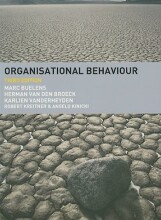Summary: Applying Uml And Patterns ... | 9780131489066 | Craig Larman
- This + 400k other summaries
- A unique study and practice tool
- Never study anything twice again
- Get the grades you hope for
- 100% sure, 100% understanding
Read the summary and the most important questions on Applying UML and patterns : an introduction to object-oriented analysis and design and iterative development | 9780131489066 | Craig Larman.
-
1 Object-Oriented Analysis and Design
This is a preview. There are 4 more flashcards available for chapter 1
Show more cards here -
1.5 A short example
This is a preview. There are 2 more flashcards available for chapter 1.5
Show more cards here -
What's a domain model
It's a model that shows the noteworthy domain concepts or objects (real-world) with their associations and attributes -
What's a sequence diagram?
It's an UML interaction diagram. It shows the flow of messages between software objects, and thus the invocation of methods -
2 Iterative, evolutionary and agile
This is a preview. There are 4 more flashcards available for chapter 2
Show more cards here -
2.1 What is UP? Are other methods Complementory?
This is a preview. There are 1 more flashcards available for chapter 2.1
Show more cards here -
What is unified process?
UP is an iterative software development process for building object-oriented systems and supporting many other iterative methods such as Extreme Programming (XP), SCRUM, Test-Driven Development -
2.2 What is iterative and evolutionary development?
This is a preview. There are 4 more flashcards available for chapter 2.2
Show more cards here -
What are benefits of iterative development?
1. Less project failure, better productivity and lower defect rates.
2. Early mitigation of high risks.
3. Early visible progress.
4. Early feedback, user engagement and adaptation.
5. Managed complexity, team is not overwhelmed by 'analysis paralysis'.
6. Learning with iteration can improve the development process itself, iteration by iteration. -
What is iterative and evolutionary development? ( contrasted with a sequential or "waterfall' lifecycle )
Early programming and test of partial systems in repeating cycles. Also development starts before all the requirements are defined in detail and feedback is used to clarify and improve the evolving specifications. -
2.3 What about the waterfall lifecycle?
This is a preview. There are 3 more flashcards available for chapter 2.3
Show more cards here -
What is the waterfall lifecycle?
A sequential development process prone to failure and not adaptive to user requirements. -
When does waterfall thinking invade iterative or UP?
When ideas appear such as:
'Lets start by writing al the use cases before starting to program'
'Lets create a full application UML'
This way of working in an iterative process is often the key reason for a failed adoption of the UP or any other iterative process. -
Why the need for feedback and adaption?
Feedback from early development; programmers trying to read the specifications and client demos to refine requirements.
Feedback from tests and developers to refine design and/or models.
Feedback from the progress of the team tackling early features to refine schedule and estimates.
Feedback from the client and marketplace to re-prioritze the features in the next iteration. -
2.5 What is Risk-Driven and Client-Driven Planning?
This is a preview. There are 2 more flashcards available for chapter 2.5
Show more cards here -
What does risk-driven and client-driven planning mean?
Identifying and drive down the highest risk features (Risk-Driven).
Building visible features the client cares about (Client-Driven).
For example:
High risk includes more specifically the the practise of architecture-centric iterative development.
Why? Because not having a solid architecture is a high risk. -
2.6 What are Agile methods and attitudes?
-
What is the reason for developing Agile methods?
System development did not progress further than the drawing table and thousands of documents were wasted en never read.
- Higher grades + faster learning
- Never study anything twice
- 100% sure, 100% understanding

































